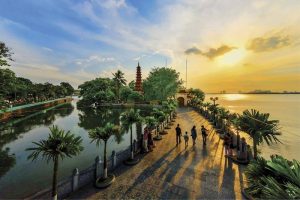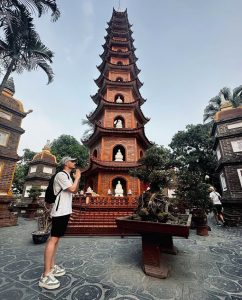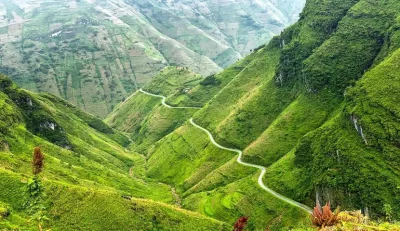Tran Quoc Pagoda, Hanoi: The Ancient Millennium-Old Temple of the Capital
Hanoi is home to many famous temples, such as Quan Su Pagoda, Perfume Pagoda, and Thay Pagoda. Tran Quoc Pagoda is also one of them. This historic pagoda holds countless fascinating aspects waiting for you to discover.
Where is Tran Quoc Pagoda Located?

Many visitors wonder about the exact location of Tran Quoc Pagoda when planning their trip. The pagoda is located at 46 Thanh Nien Street, Yen Phu Ward, Tay Ho District, Hanoi. Nestled on a small island in the breezy West Lake, along the bustling Thanh Nien Street, Tran Quoc Pagoda stands as a serene and solemn landmark, enhancing the area’s beauty.
When it comes to Hanoi tourism, Tran Quoc Pagoda is always one of the must-visit destinations. Now that you know its location, why hesitate? Gather your group and head there to explore its beauty! A visit to Tran Quoc Pagoda will undoubtedly offer many interesting insights.
Opening Hours and Entrance Fees
- Opening hours:
- Open daily from Monday to Sunday: 8 AM – 4 PM
- On the 1st and 15th days of the lunar month: 6 AM – 6 PM
- Entrance fee: Free for both locals and tourists
How to Get There
Located in the city center, getting to Tran Quoc Pagoda is extremely simple. Parking is available nearby, allowing visitors to arrive by both car and motorbike. However, during holidays or weekends, the temple can become quite crowded, leading to traffic congestion.

From Hoan Kiem Lake, take the route Tran Nhat Duat – Yen Phu – Yen Phu Overpass – Nghi Tam – Thanh Nien to reach the pagoda in just about 15 minutes. Depending on your starting point, choose the most suitable route.
For those traveling by bus, the recommended routes are 41, 50, and E05, which all stop close to the pagoda’s entrance. From there, it’s just a short walk to the temple.
Discovering Tran Quoc Pagoda from A to Z
Who is Worshipped at Tran Quoc Pagoda?
As a Northern Buddhist temple, Tran Quoc Pagoda worships Amitabha Buddha, Avalokiteshvara Bodhisattva, and Shakyamuni Buddha. The main hall still preserves many valuable Buddha and Bodhisattva statues.
According to previous visitors, Tran Quoc Pagoda is renowned for its spiritual significance. Many people come here to express their reverence and pray for peace and good fortune. Offerings typically include incense, fruit, flowers, votive money, and prayer texts for the Three Jewels, Deity of the Temple, and Avalokiteshvara Bodhisattva. However, the most important aspect is not elaborate offerings but the sincerity of one’s heart.
When visiting Tran Quoc Pagoda, take a moment to relax, clear your mind, and let your prayers come from the deepest sincerity of your heart.
The Architecture of Tran Quoc Pagoda
Tran Quoc Pagoda was once listed among the 16 most beautiful pagodas in the world, alongside renowned temples such as Gyeongbokgung Palace (South Korea), Byodo-In Temple (Hawaii, USA), Cebu Taoist Temple (Philippines), and Meidai Lamasery (Inner Mongolia, China).

This makes the architectural beauty of Tran Quoc Pagoda truly outstanding. It is one of the oldest pagodas in Vietnam, originally built in 541 AD during the Early Ly Dynasty in Yen Hoa village (later renamed Yen Phu) under the name Khai Quoc Pagoda. At that time, it stood on a plain near the Red River.
In 1615, due to riverbank erosion, the pagoda was relocated to a small island on West Lake, called Kim Ngu Island, where it still stands today. In the 17th century, Lord Trinh constructed the Co Ngu Dyke to connect the island with the mainland. During the reign of King Le Hy Tong (1681 – 1705), the pagoda was officially renamed Tran Quoc, symbolizing its role in bringing peace and dispelling calamities for the people.
Despite undergoing multiple renovations over the centuries, Tran Quoc Pagoda has largely retained its original structure and layout.
The pagoda consists of three main sections: the Front Hall (Tien Duong), the Incense House (Nha Thieu Huong), and the Upper Hall (Thuong Dien), arranged in a 工 (Gong) character layout. The courtyard features numerous exquisite bronze Buddha statues. Behind the Upper Hall stands a three-room Bell Tower, along with the ancestral house and stone steles on either side.
The red-tiled roof, now covered in moss, adds to the ancient and solemn charm of Tran Quoc Pagoda. Along the main hall, intricate carvings decorate the walls, with gilded Buddha and Bodhisattva statues, as well as guardian statues protecting the sacred space.
One of the most striking features is the Lục Độ Đài Sen Stupa, an 11-tiered lotus tower standing 15 meters tall with a 10.5-meter-square base. Constructed in 1998, each level has six arched windows, each housing a jade Amitabha Buddha statue. At the top of the tower is a nine-tiered lotus pedestal, also carved from precious stone, symbolizing the Nine Lotus Stages of Enlightenment in Buddhism.
Opposite the stupa stands a sacred Bodhi tree, gifted by the President of India in 1959 during his visit to Hanoi. This tree was propagated from the original Bodhi Tree at Bodh Gaya, where Shakyamuni Buddha attained enlightenment over 25 centuries ago. The thriving tree, with its wide-spreading branches, enhances the serene and spiritual atmosphere of the pagoda.
Historical and Spiritual Significance
Since ancient times, Tran Quoc Pagoda has been a Buddhist center frequented by the Ly and Tran dynasties during major festivals. Today, it continues to be a place of worship for locals and visitors from across the country.
The pagoda preserves 14 ancient stone steles, recording important details about its restoration over the years, including in 1624, 1628, 1639, 1815, 1821, and 1842. Among these, notable inscriptions include those by Nguyen Xuan Chinh (1587 – 1693), a top scholar of the Le Dynasty, and Pham Quy Thich (1760 – 1825), a renowned Confucian scholar.
Despite enduring centuries of historical upheaval, Tran Quoc Pagoda remains an iconic landmark in Hanoi. Strolling around West Lake, visitors are always drawn to admire this magnificent temple standing proudly against the modern cityscape.
Nestled in a tranquil and breezy setting, Tran Quoc Pagoda offers a spiritual retreat amid the bustling capital, making it a must-visit destination for those seeking peace, history, and divine beauty.
In conclusion, Tran Quoc Pagoda in Hanoi is not only one of Vietnam’s oldest temples but also a sacred destination rich in historical, cultural, and architectural significance. Nestled by the tranquil West Lake, the pagoda attracts visitors from near and far who seek to explore its beauty, pay their respects, and find peace amidst the bustling capital. If you have the chance to visit Hanoi, don’t miss the opportunity to discover Trấn Quốc Pagoda – a remarkable symbol of spirituality and heritage in Vietnam.
Before taking the trip to Hanoi, you should apply for a visa first. Feel free to contact Vietnam Visa Express for help!



